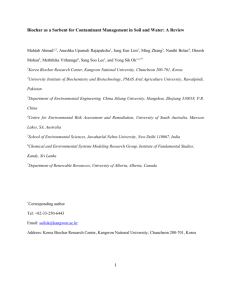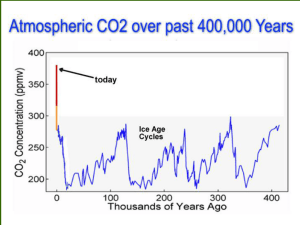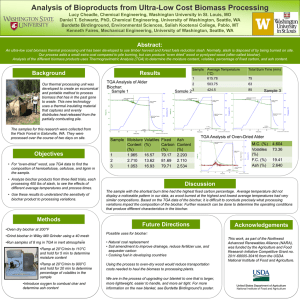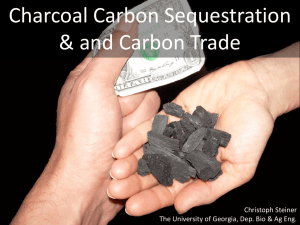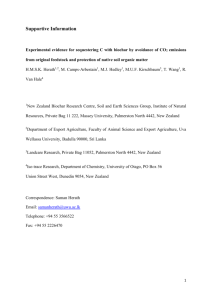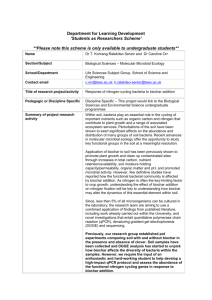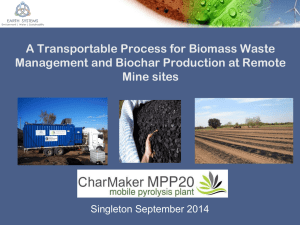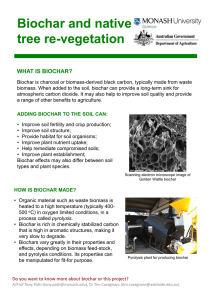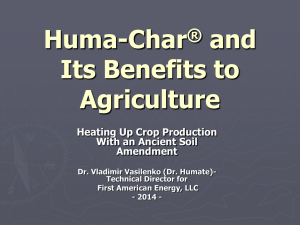File - Richmond Landcare
advertisement
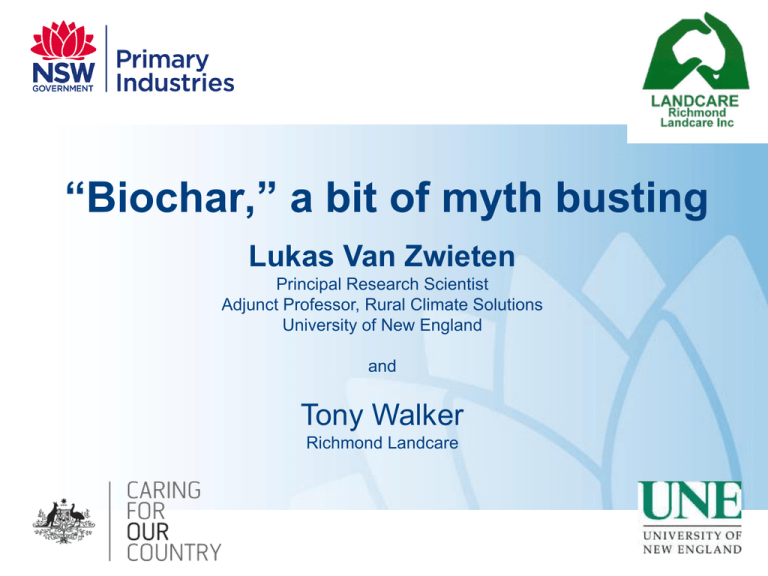
“Biochar,” a bit of myth busting Lukas Van Zwieten Principal Research Scientist Adjunct Professor, Rural Climate Solutions University of New England and Tony Walker Richmond Landcare What is biochar and how is it made? Biochar and Terra Preta Downie, AE., Van Zwieten, L., Smernik RJ., Morris, S., Munroe, PR (2011) Terra Preta Australis: Reassessing the carbon storage capacity of temperate soils. Agriculture Ecosystems Environment 140, 137147. Pyrolysis is an engineering term “energy and biochar can be produced” Why pyrolyse biomass Biosecurity Odour Concentration of C and nutrients Transport costs Beneficial agricultural reuse Renewable energy Biochar is carbon that is going to last for hundreds of years A Biomass carbon 100% Energy Production Bio-char carbon 50% Biomass carbon 100% 100 years Biomass carbon 0% Bio-char carbon >40% Diagram source: Lehmann et al., 2006, Mitigation and Adaptation Strategies for Global Change Agronomic trials Over 350 plots being managed as part of the Richmond Landcare collaborative project Key soil constraints on ferrosols Declining C Immobilisation of P Low pH High Al saturation Low CEC Biochar “can” significantly improve soil fertility and crop production 1900mm 1200mm Control corn (13t cob/ha) Poultry litter biochar, 50t/Ha (35t cob/ha) Long-term field sites testing biochar Trials in a macadamia orchard 45 trees used testing poultry litter char and greenwaste char (@10t/ha- 40kg per tree) 2 years on Trials in coffee 2 years on 3.3kg per tree, 30 trees per block, 4 treatments, 4 replicates, testing poultry biochar and rice husk biochar Sections of x-ray computed tomography scans of a vertosol soil, packed into tubes of ~ 30 mm, at a resolution of 70 µm control 1% biochar P Quin (PhD student) and I Young 5% biochar Summary of effects of some biochars in some soils Properties of biochar Soil and crop outcomes • Increases in nutrient use efficiency allowing reduced fertiliser inputs • Improved water use efficiency • Reduced leaching and gaseous losses of fertiliser • Reduced denitrification • Lowered Al toxicity • Reduced heavy metal bioavailability • Increased P availability on P sorbing soils • Improved mycorrhizae and biological N2 fixation • Long-term accumulation of soil C Nutrients Stable C content Liming effect Reactive surfaces and redox CEC and AEC Porosity/ water holding capacity and bulk density Porosity / microbial habitat Smoke chemicals? Myth Busting Not all biochars will be valuable Biochars may not be beneficial in all soil types Value of the crop will limit application of biochar- and bottom line Biochar certification is coming More myth busting Understand biochar characteristics to ameliorate soil constraints Farming system impacts the way biochar works: Possible C accumulation under permanent pasture, but tillage and biomass removal under cropping can still result in a decline in C Biochar can particularly target chemical constraints in ferrosols including low pH, high Al availability and low P availability Biochars with high mineral ash component are more effective at improving crop production Biochars with high C content are more effective at accumulating additional C in soil
